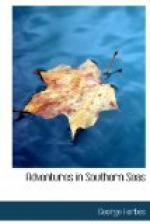As we proceeded along the coast, the weather being now clear and fine, we observed great stretches of country, flat and uninviting, upon which there appeared to be no sign of life. Indeed, the whole of this southern continent seems to be sparsely populated when compared with the islands, upon most of which the native inhabitants are very numerous. In this may be seen the hand of an all-wise Providence. In the ages to come a white population will, no doubt, emigrate to New Holland, and if this great continent was found to be densely populated by a black people, it would be a work of great difficulty to overcome them. Whereas, the aboriginal population being scant by reason of the barren nature of the country, the task of colonization by the whites would be easy. We often sailed for more than a week at a time along this coast without seeing any sign of human habitation, and those natives whom we did see were of so poor a description and appeared to be so frightened of us and of our vessel as hardly to deserve the name of humans.
And now we approached some cliffs, beyond which appeared a lofty range, which, from our present position, and the bearings given on Marco Polo’s chart, Hartog declared to be the Ruby Mountains.
As we approached the cliffs, a bold headland, which stood between us and a view of the coast beyond, assumed the appearance of a lion’s head. The resemblance was so striking that it appeared as if the mighty hand of Nature had hewn a colossus from the living rock in the shape of a lion to guard the entrance into this land.
Upon rounding this remarkable promontory, we found ourselves opposite a beach bordered by a broad line of surf, which indicated that the water here was very shallow for some distance from the shore. Both the surf and the beach seemed to be alive with black children, so diminutive were the forms who disported themselves in the breakers, or ran up and down upon the sand with the eagerness and agility generally displayed by boys at the seaside. As to the real ages of these people, however, we were not left long in doubt. Four canoes put off from the shore and came alongside. They were manned by twenty-five blacks, who, notwithstanding their small stature, we could see at a glance were full-grown men. We made signs to them to come aboard, but they were evidently in doubt whether or not to accept our invitation. We then threw out to them some small pieces of iron and strings of beads, at which they showed great satisfaction. These little men appeared to be an intelligent race. Their bodies were small, but their heads, in proportion, were large. They wore no beards, but their hair was curly like the Kafirs, some of them wearing it tied to the neck in a knot, and others letting it fall loose down to the waist. All of them had holes through their noses to carry fish bones, polished white. Some wore strings of human teeth round their necks.




